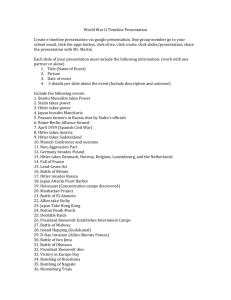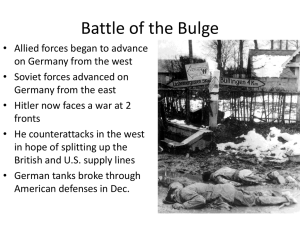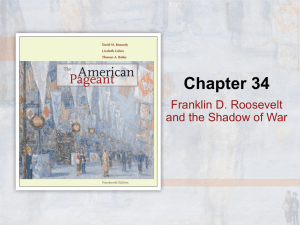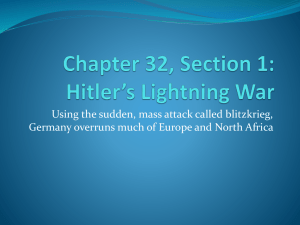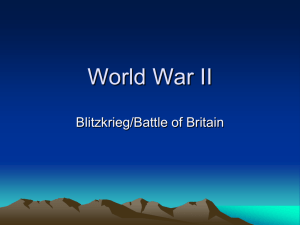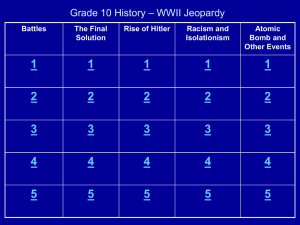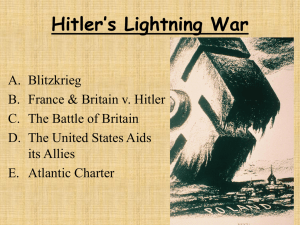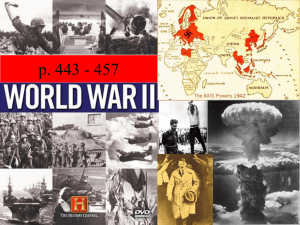Lecture Outline: World War II APUSH A. World War II Quick Facts
advertisement
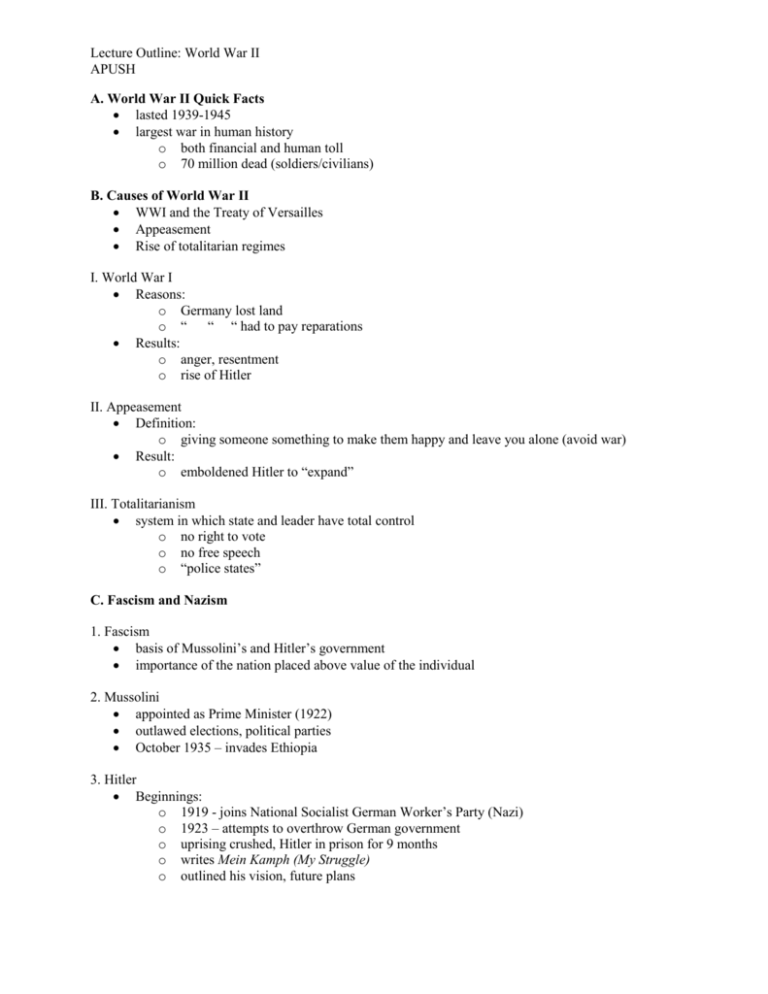
Lecture Outline: World War II APUSH A. World War II Quick Facts lasted 1939-1945 largest war in human history o both financial and human toll o 70 million dead (soldiers/civilians) B. Causes of World War II WWI and the Treaty of Versailles Appeasement Rise of totalitarian regimes I. World War I Reasons: o Germany lost land o “ “ “ had to pay reparations Results: o anger, resentment o rise of Hitler II. Appeasement Definition: o giving someone something to make them happy and leave you alone (avoid war) Result: o emboldened Hitler to “expand” III. Totalitarianism system in which state and leader have total control o no right to vote o no free speech o “police states” C. Fascism and Nazism 1. Fascism basis of Mussolini’s and Hitler’s government importance of the nation placed above value of the individual 2. Mussolini appointed as Prime Minister (1922) outlawed elections, political parties October 1935 – invades Ethiopia 3. Hitler Beginnings: o 1919 - joins National Socialist German Worker’s Party (Nazi) o 1923 – attempts to overthrow German government o uprising crushed, Hitler in prison for 9 months o writes Mein Kamph (My Struggle) o outlined his vision, future plans Lecture Outline: World War II APUSH Goals in Mein Kamph o buildup of military o territorial expansion o removal of all non-Aryans Promises of Hitler o return of economic stability o restore the German Empire (Third Reich) Taking Power: o 1933 – Nazi’s dominate parliament o Hitler becomes leader, outlaws opposition o becomes Der Fuhrer (dictator) D. Early Aggression of Hitler 1. First Targets The Rhineland (March 1936) Austria (March 1938) Sudetenland (1938) 2. Attempt at Appeasement (Big Mistake) September 1938 – Munich Conference Britain and France want to avoid war appease Hitler, let him keep Sudetenland 3. Continued Aggression Germany takes over all of Czechoslovakia (March 1939) invades Poland (September 1939) o blitzkrieg (lightning war) finally Britain and France declare war invades Norway and Denmark (April 1940) invades Belgium, France (May 1940) 4. Fall of France June 14, 1940 o Germans enter Paris June 22, 1940 o France surrenders o leaves Britain as only Allied Power E. Battle of Britain largest air assault in history Hitler uses Luftwaffe (air force) o massive bombing runs The Blitz o September 1940 – May 1941 o constant bombing of Britain o heavy losses, panic Lecture Outline: World War II APUSH F. Japanese Aggression 1. Background 1920s o lack sufficient raw materials, markets o begin to seek imperial claims in Asia 1931 o seize Manchuria 1940 o controls Eastern China September 1940 o becomes allied w/ Germany, Italy April 1941 o non-aggression pact with Soviet Union G. The American Response 1938 o begin buildup of Pacific fleet 1939 o move fleet to Pearl Harbor, Hawaii Mid 1930s – Neutrality Acts o purpose – dealing with own problems (Depression) o no weapons to nations at war o “cash and carry” – must buy goods w/ cash and transport yourself Neutrality Act of 1939 o Britain and France can buy weapons on a cash and carry basis Lend-Lease Act (1941) o provide aid to any country whose defense is vital to American security o “arsenal of democracy” H. Pearl Harbor Origin o 1941 – Japan takes over French Indochina o FDR cuts off trade relations in response October 1941 o Hideki Tojo becomes Prime Minister o realizes more expansion impossible w/ U.S. in Hawaii “A Date Which Will Live in Infamy” o Dec. 7, 1941 o massive aerial strike by Japanese o 2,400 Americans dead in two hours o 18 warships sunk/heavily damaged Dec. 8, 1941 o U.S. declares war on Japan Dec 11, 1941 o Germany, Italy declare war on U.S. Lecture Outline: World War II APUSH I. The War In Europe 1. The Atlantic Charter August 1941 o FDR/Winston Churchill (British PM) o agreement about what post war world should look like Battle of the Atlantic Germany U-Boats v. American convoys o “cat and mouse” to get supplies to Britain o Allied victory b/c of sonar, radar 3. North Africa November 18, 1942 – Operation Torch o Brit/U.S. attempt to control the Mediterranean o v. Erwin Rommel – German commander o “The Desert Fox” May 1943 o Rommel surrounded, surrenders o Allies hold all N. Africa 4. Invasion of Italy July 1943 o begins w/ invasion of Sicily o Mussolini arrested, rescued by Germans June 1944 o Allies enter Rome 5. Operation Barbarossa 1939 – Germ. and Soviets sign non-aggression pact 1941 – Hitler breaks, invades o needs lebensraum (living space) Characteristics of Barbarossa o largest offensive in history (4.5 million troops) o highest death tolls o major turning point of war German Advance (1941-42) o Soviets retreat, adopt scorched earth policy o burn anything that can be used by enemy Battle of Stalingrad (1941-42) o bloodiest battle in history (2 million casualties) o Germans finished off by harsh winter J. The End of War In Europe 1. The Tehran Meeting Churchill, FDR, Stalin Purpose: simultaneous offensive in Europe and Russia Lecture Outline: World War II APUSH 2. Operation Overlord (D-Day) Allied invasion of France June 6, 1944 o 4,000 ships/150,000 men o allowed for 2 million Allies to land by July 3. The Battle of the Bulge December 1944 o largest battle fought by U.S. army 4. End of Hitler May 1, 1945 o Allies surround Berlin o Hitler refuses to flee, commits suicide May 8, 1945 (V-E Day) o Germany surrenders 5. Yalta Conference February 1945 o Stalin, Roosevelt, Churchill o agree to split Germany into 4 zones o leads to beginning of Cold War I. World War II (Pacific) 1. Battle of Midway June 1942 o most important battle of the Pacific o damaged Japanese ships to the point they could no longer launch offensive attacks 2. Island Hopping capturing strategic islands and setting up airfields on them bypassing heavily defended routes “paving a road to Japan” 3. Battle of Guadalcanal August 1942 o Japan’s first defeat on land o allowed U.S. to reach Japan w/ bombers 4. Iwo Jima March 1945 o location critical to bomb Japan o island taken in extremely bloody battle 5. Okinawa June 1945 o Japan’s last defensive outpost o now in position to directly attack Japan Problem… invasion of Japan = thousands of American casualties Lecture Outline: World War II APUSH 6. July 1945- Potsdam Conference Allies want unconditional surrender 7. Manhattan Project development of the atomic bomb by J. Robert Oppenheimer 8. Hiroshima August 6, 1945 o Enola Gay and Little Boy o Japan refuses to surrender 9. Nagasaki August 9, 1945 10. Why Did Truman Use the Bomb? avoid U.S. casualties impress Soviets minimize Soviet presence in Pacific

